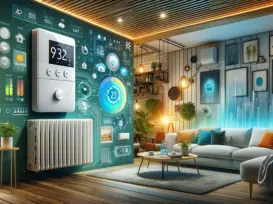Grus Home Energy - Sustainable heating and cooling
Eco-Friendly Temperature Control: Harnessing Sustainable Heating and Cooling Solutions
Eco-Friendly Temperature Control: Harnessing Sustainable Heating and Cooling Solutions
As the world increasingly feels the impact of climate change, the quest for sustainable heating and cooling solutions has never been more critical. Traditional HVAC (Heating, Ventilation, and Air Conditioning) systems are known for their high energy consumption and substantial carbon footprint. However, with advancements in technology and a growing environmental consciousness, a new wave of eco-friendly temperature control is emerging. These innovative systems not only help in reducing greenhouse gas emissions but also improve energy efficiency and result in long-term cost savings.
Sustainable heating and cooling solutions draw on renewable energy sources such as solar power, wind energy, and geothermal energy. Solar thermal panels, for instance, can be used to heat water and air, reducing the reliance on fossil fuels. Wind energy, captured through turbines, can generate electricity to power heat pumps, which are far more efficient than traditional heating systems. Geothermal heating and cooling harness the constant temperature of the earth’s crust, providing an efficient and reliable source of temperature control all year round.
One of the most promising developments in sustainable temperature control is the heat pump. Heat pumps work by transferring heat from one place to another. During the winter, they pull heat from the outside air or ground to warm the interior of a building. In the summer, the process is reversed, with heat pumps moving warm indoor air outside, thus cooling the building. Since heat pumps move heat rather than generate it, they can provide up to four times the amount of energy they consume.
Another innovative approach is the use of phase-change materials (PCMs). PCMs absorb and release thermal energy during the process of melting and freezing, helping to maintain a steady temperature in buildings. This material can be incorporated into wallboards, floors, and ceilings to reduce the need for active heating and cooling systems.
Building design also plays a pivotal role in sustainable temperature control. Passive solar design involves constructing buildings with materials that absorb and slowly release the sun’s heat. Strategic placement of windows and the use of thermal mass help to keep buildings warm in the winter and cool in the summer. Green roofs, which are covered with vegetation, can also insulate buildings and reduce urban heat islands, contributing to cooler urban environments.
In addition to these technologies, simple steps such as improved insulation, energy-efficient windows, and smart thermostats can greatly enhance a building’s energy performance. Insulation helps to keep the desired temperature inside, reducing the workload on heating and cooling systems. Energy-efficient windows minimize heat loss in the winter and heat gain in the summer, while smart thermostats optimize HVAC system operation based on real-time conditions and user preferences.
The importance of sustainable heating and cooling extends beyond environmental benefits. It is also about creating healthier indoor environments, reducing energy poverty, and ensuring energy security for future generations. While the initial costs of these systems may be higher than traditional options, the long-term savings and benefits are a worthwhile investment.
As we move forward, it is crucial for governments, businesses, and individuals to promote and adopt sustainable heating and cooling practices. Incentives for green building practices, stricter energy efficiency standards, and education about the benefits of sustainable temperature control can accelerate the transition to a greener, more sustainable future. The challenge lies not in the availability of technology, but in the willingness to implement it on a broad scale.
Blog, Smart Home Automation , February 19, 2024 , Energy Consumption Monitoring, Energy-saving technology for homes, Enhancing Heat Pump Efficiency, Green home solutions, Heat pump efficiency, HEMS, Home Energy Management Systems, HVAC optimization, Intelligent climate control, Real-time energy data analysis, Smart Thermostats, Sustainable heating and cooling
©2025 All Rights Reserved. Grus IoT Co.,Ltd.
